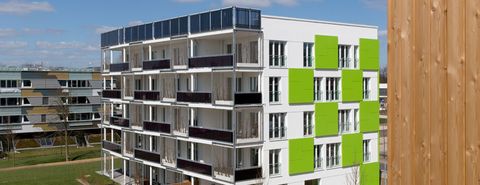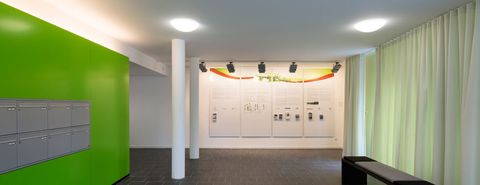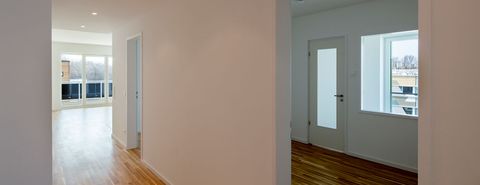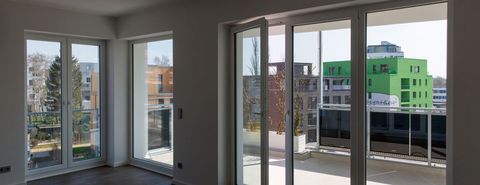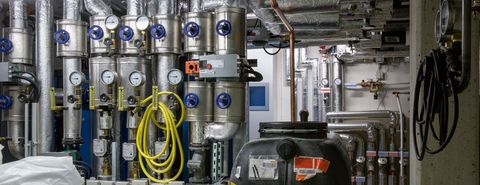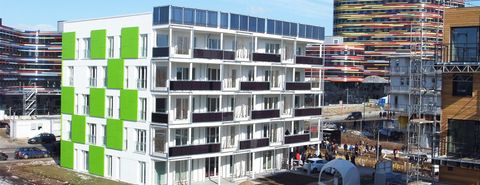SIMILAR PROJECTS
Cities and Climate Change
 A virtual power station - in the network of synergies
A virtual power station - in the network of synergies
Integrated Energy Network Wilhelmsburg Central
to the projectMetrozones
 Houses built in a beautiful, inexpensive way
Houses built in a beautiful, inexpensive way
Smart Price Houses
to the projectSmart is green
An “energy-smart façade” that generates and stores energy throughout the year makes this house, designed by zillerplus Architekten und Stadtplaner München, an “efficient house plus” – a building that is capable of generating more energy than its residents use. This is made possible by techniques such as the use of particularly clever phase-change materials (PCMs), which are also used in “pocket warmers”.
One Façade, Three Layers: all the Better for the Climate
The outer shell of the Smart is Green building is made up of layers including a vertical garden façade that acts as a heat shield during summer, along with insulating glazing, which protects from both heat and cold, and a PCM “curtain”. PCMs are in a constant aggregate state between solid and liquid. Like “pocket warmers”, which absorb heat when immersed in hot water and can be used to warm freezing hands when it is cold, these materials can absorb the warmth from the sun’s energy and release it later. Excess heat is thus removed from the area during the day, preventing the apartments from overheating. This stored heat is then released during the cooler hours of the night. Peak temperatures during both summer and winter can thus be intercepted and balanced out, resulting in a very pleasant interior climate.
Phase change material (PCM) is, moreover, used as a central storage unit for heat; divided into two tanks, its volume is only half that of a conventional unit. Excess heat from the solar thermal system is stored here at the temperature needed to operate the underfloor heating, and any excess heat that is generated is fed into the Wilhelmsburg local heating network (Wilhelmsburg Central Integrated Energy Network). In return, the local heating network ensures that heating is always available when needed, especially in long periods of cold weather.
In addition, the outer skin is equipped with photovoltaic panels to transform solar energy into electrical power, while solar thermal arrays on the roof convert sunlight into thermal energy. The façade and roof of the “Smart is Green” house are thus an active part of a sophisticated building services concept. Using innovative technology, they generate power that is fed directly into the house. At the same time they are part of the architectural concept.
Tomorrow’s Properties Will Help their Residents to Get Around
Like all of the concepts behind the Smart Material Houses, the façade with its clever materials is not the only innovative element – the integrated concept for the whole project is also groundbreaking. In Smart is Green this can be seen in the ground plan and the way in which it can be accessed, with various entrances to the individual apartments via stairs or lifts. The house is laid out so that the apartments can be configured or modified in a versatile way, allowing them to be partitioned or extended in order to meet the needs and changing living arrangements of their inhabitants.
Additional attractions of “green living” are the spacious patios with their own little gardens located between the planted and glazed elements on the south-facing side of the building.
The Technical Innovation Doesn’t Stop with the Building
Just in front of the green façade are facilities for providing green energy for getting around in the future, in the form of a fast charging station for electric cars. On top of that, they are of course part of the mobility concept, because a car-sharing scheme is available to the residents. E-cars also form a natural part of the mobility concept, as a car-sharing system is planned for the residents. All of this will make car-sharing among neighbours an attractive alternative to owning private vehicles. Extra charging devices for electric bicycles and scooters can also be installed in combi-boxes on the ground floor upon request.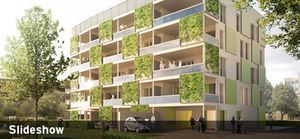
ADDRESS
Am Inselpark 9
21109 Hamburg
SPECIFICATIONS
Beginning of construction:
May 2012
Completion:
März 2013
Project costs:
approx. 4,4 Mio. Euro
Size of site:
approx. 1,250 sqm
Gross floor area:
approx. 1,990 square metres
Size of utilisation units:
86 – 127 sqm
Energy standard:
Passive house standard
Energy supply: Solar thermal cells, photovoltaic elements, PCM technologyIntegrated Energy Network Wilhelmsburg Central

